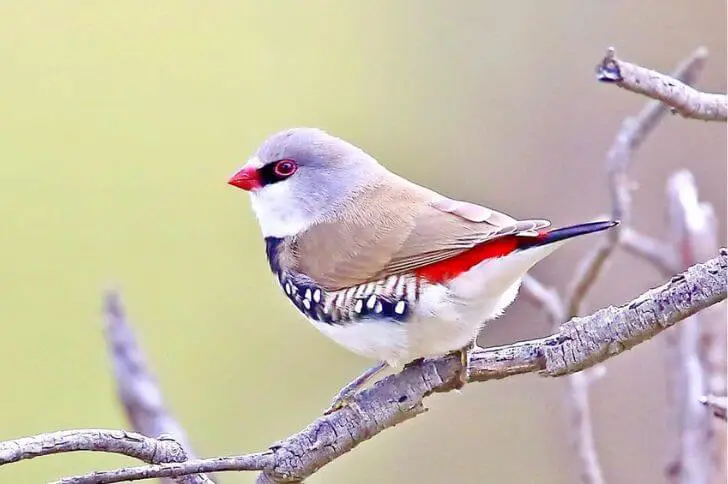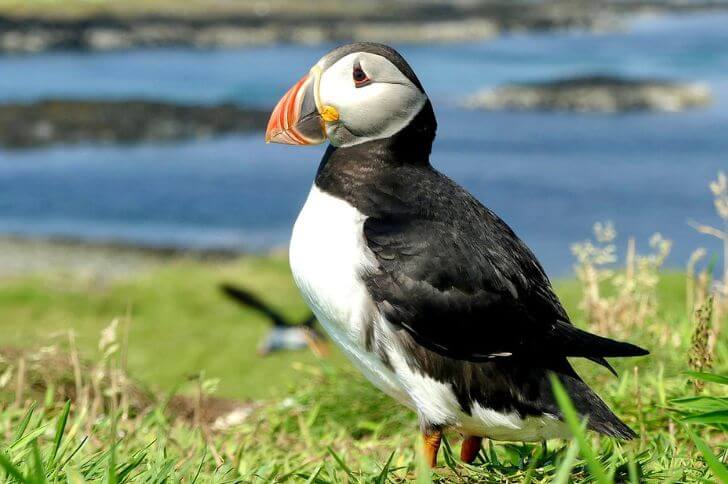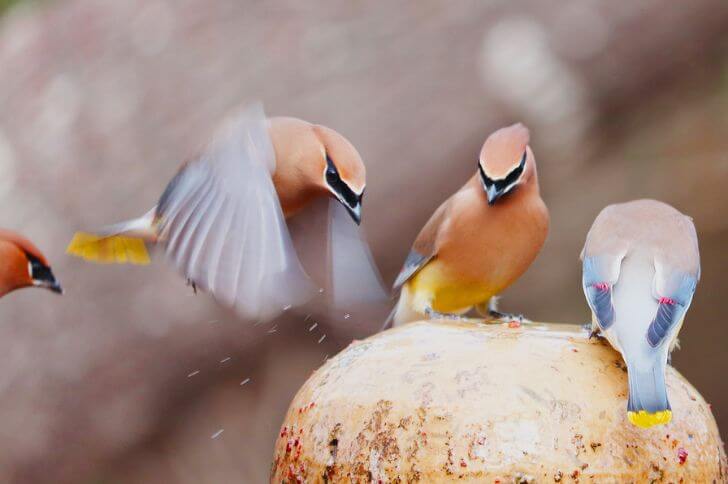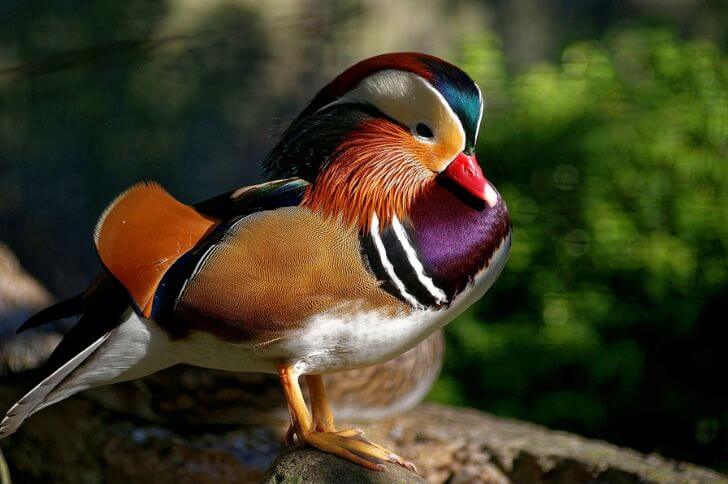Like many bird watchers, I have experienced the joy of watching different avian species. Some are big, some are small, and some are dull while others are brightly colored. Below I’ll list pretty birds I’ve come across and add a few suggested by fellow birding enthusiasts.
I’ll not only focus on common backyard birds in North America but also beautiful birds from other parts of the world. So whether you are looking to identify a bird you saw at your local park or birds you can see when you visit a particular country, keep reading.
List of Beautiful Birds
1. Scarlet Macaw

The scarlet macaw is one famous bird. It is one of the prettiest birds in nature because of its colorful plumage.
Identification:
The scarlet macaw is a large red, yellow, and blue South American parrot. On average the adult is about 32 inches long; 5 times the size of a downy woodpecker. It is a member of the Ara genus of New World parrots and is one of the most popular pet birds.
This beautiful bird is native to humid evergreen forests in the American tropics. The scarlet macaw typically lives about 30 years in the wild and longer in captivity. In the wild, the bird feeds on fruits, nuts, seeds, and leaves.
Most pet owners love these feathered friends because of their ability to mimic human speech and intelligence.
2. Golden Pheasant

Also known as the rainbow pheasant or Chinese pheasant, the golden pheasant is a beautifully ornate bird that is native to China. These birds are found in mountain forests and are known for their long tail feathers.
Identification:
The male golden pheasant is particularly striking, with bright gold and red plumage. Notice the golden yellow mohawk and the scarlet breast.
Female golden pheasants are more subdued in color, but no less lovely. These birds are not commonly kept as pets, but those who do keep them find them to be gentle and affectionate creatures.
Also, during nesting season these cool looking birds lay up to 12 eggs that they incubate for up to 3 weeks.
3. Diamond Firetail

I think diamond firetails are one of those rare beautiful birds in the world. A member of the estrildid finch family, the Stagonopleura guttata or diamond firetail is a pretty little bird that is found in Australia.
Identification:
It is a member of the finch family and its name comes from the bright red undertail. These nice birds have gray upperparts and white below. Note the black band that stretches from the throat to the flanks. Also the sides have white spots which complement the white belly.
Both sexes are about 4.7 inches long, same size as a chickadee, and have bright red bills. How long do diamond firetails live? About 7-10 years. Also their population has decreased in recent years, leading the IUCN classifying them as vulnerable.
The diamond firetail is found in open woodlands, shrublands and grasslands across Australia. It feeds on spray millet, mealworms, lettuce, and cockroaches.
4. Keel-billed Toucan

A keel-billed toucan is a tropical bird that is native to Central and South America. How to identify this toucan.
Identification:
This pretty big bird is known for its large, colorful bill. The keel-billed toucan’s bill is about one third of the bird’s body length. Adults are typically 17-22 inches with a body mass of 17 oz.
Their body is overall black with a yellow breast and neck. An important thing I’d like you to note about this toucan is the unique feet; zygodactyl feet.
The keel-billed toucan is an omnivorous bird. Its diet consists of fruits, eggs and lizards. Did you know it can swallow fruits whole! This pretty bird is also called the rainbow billed toucan or sulfur breasted toucan.
5. Sulphur-crested Cockatoo

Sulphur-crested cockatoos are one of the most popular cockatoo species in the world. They are native to eastern Australia and New Guinea.
Identification:
They are known for their beautiful sulfur-yellow crest and their loud, screeching calls. The rest of their 20-inch body is whitish. Note the dark bill.
They prefer areas with plenty of trees but they are also commonly found in urban areas, where they often become pests because of their loud calls and messy habits.
Sulphur-crested cockatoos are intelligent birds that can learn to imitate human speech. They are also very skilled at using their beaks to open doors, cupboards, and other objects.
6. Blue Jays

I think blue jays are one of the prettiest birds in North America. And here is why.
Identification:
The blue jay is known for its blue plumage and its loud “jeer” calls; making it a popular bird among birdwatchers. It has a body length of 9-12 inches and a wingspan of 13-17 inches. The males and females are similar in size and appearance. The blue jay has a black bill, black legs, and blue wing feathers with white bars. The tail is long and pointed.
This cute bird can be found in woodlands, gardens, and urban areas. It is an opportunistic feeder; eating other birds eggs, acorns, and grains. When can you see a blue jay’s early stages of Life? Spring and summer; be sure to install peanut bird feeders to attract them.
7. Atlantic Puffins

The Atlantic puffin is a small seabird that is found along the coasts of North America and Europe.
Identification:
These birds are easily recognizable by their brightly colored beak and its black and white plumage.
Atlantic puffins breed in colonies on rocky islands and cliffs, where they build their nests in a burrow. They feed on small fish, which it catches by diving into the water from the air.
In recent years, the Atlantic puffin population is declining. However, the bird is still relatively common and can be seen in many coastal areas.
8. Cedar Waxwing

Found across North America, Cedar waxwings are a species of bird that is known for its unique appearance and beautiful song.
Identification:
These pretty birds are medium-sized birds with sleek bodies and long tails. Their most distinguishing feature is its red-tipped gray wings and yellow-tipped gray tails.
The cedar waxwing is a social creature and often seen in flocks of up to 100 birds. It favors dogwood, raspberries, cedar berries and insects such as mayflies, and stoneflies. Cedar waxwings are known to be very friendly birds.
9. Bee Hummingbird

Do you know the smallest, prettiest bird?
Identification:
Measuring just 2.24 inches from beak to tail, it is barely larger than a bee. Females bee hummingbirds are slightly larger than male of their species. Males have bluish feathers on thir back and grayish below. Females also have gray underparts and bluish-green above.
Despite its size, the bee hummingbird is an expert flyer like other members of its family. The bee hummingbird is found in Cuba. It feeds on nectar and insects, which it catches in mid-flight. The bird’s rapid metabolism means that it must eat constantly to survive.
These pretty birds breed starting March through June and females lay two eggs.
10. Wood Duck

Wood ducks are one of the most striking and colorful of all North American waterfowl.
Identification:
The males have a distinctive multi-colored plumage, while the females are more drab in coloration. Wood ducks are relatively small compared to other duck species, with a length of only 18-21.3 inches. They are also one of the few species of ducks that are capable of perching in trees.
Wood ducks inhabit wooded swamps, marshes, and rivers throughout much of North America. Their diet consists primarily of aquatic invertebrates such as insects, crustaceans, and snails. They are strong flyers and are known for their graceful aerial displays.
11. Livingstone’s Turaco
Livingstone’s turaco is a species of bird in the Musophagidae family. They are named after a famous missionary, Charles Livingstone.
Identification:
It is found in parts of Africa. Adults have a green head, neck and chest. Note the white tipped green crest.
Rest of its body is bluish-green and a scarlet bill. They also have long tail feathers. The legs are short and stout.
This colorful bird feeds on fruits, buds, flowers, and leaves. This turaco nests in buildings or trees.
12. African Emerald Cuckoo

African emerald cuckoos are brightly colored birds found in woodlands throughout sub-Saharan Africa.
Identification:
The male cuckoo gets its name from its emerald green plumage on their upperparts, yellow below and distinctive call. Females are also green with a brownish back and heavily barred underneath. Both sexes have long tails.
This pretty bird is a member of the cuckoo family, which includes more than 130 species of birds found on every continent except Antarctica. Cuckoos are known for their unique calls, which vary widely among different species. The African emerald cuckoo’s call has been described as soft “hello ju-dy”
13. Amazonian Royal Flycatcher
With a small body and incredible crest, the Amazonian royal flycatcher is a colorful bird of the Amazon rainforest.
Identification:
It is a brown bird with yellowish underparts and a distinctive crest on its head. Note the reddish-brown tail feathers.
The Amazonian royal flycatcher is an important part of the rainforest ecosystem, as it helps to control populations of insects.
14. Aplomado Falcon

Found in South Texas, the Aplomado Falcon is a beautiful bird of prey that is easily identifiable.
Identification:
This long-tailed falcon is about 12-16 inches long with a slender body. As for their body mass, males are lighter (7.3-10.8 oz) while females are 9.6-16 oz.
The Aplomado Falcon has a long tail and wings, and a short, rounded head. Its plumage is mostly grey, with whitish chest and rusty lower belly and undertail coverts.
This pretty bird of prey hunts medium-sized birds such as doves and quail. It also eats lizards, snakes, and rodents. The Aplomado Falcon breeds in open areas such as savannas, grasslands, and deserts. It nests in trees or on cliffs, and lays two to four eggs at a time.
15. Azure Kingfisher

Azure kingfishers are some of the most colorful birds in the world. Are they rare?
Identification:
Native to Australia, these small pretty birds are fairly common in their range. To identify the azure kingfisher, be on the look for a 6.7-7.5 inch bird. Slightly smaller than a red-headed woodpecker.
The head, back and wings are blue, while the underparts are rufous-buff. The bill is black and the legs are reddish-orange. It is found near water, where it perches on branches or reeds, waiting to swoop down and catch its prey. It mainly eats insects and small fish. The Azure kingfisher’s calls include high-pitched “pseet-pseet”.
16. Bald Eagle

The bald eagle, with its distinctive white head, is a symbol of strength, courage, and freedom for the United States of America. I believe this national bird is not only powerful but beautiful.
Other facts:
This magnificent North American bird can be found living near large bodies of open water where they build their nests.
Bald eagles are apex predators and primarily eat fish, which they catch by swooping down from the sky and grabbing them with their powerful talons. These birds are incredibly important to the ecosystem and are protected.
Despite their status as a national icon, bald eagles were once on the brink of extinction due to hunting and habitat loss. Thanks to conservation efforts, their population has rebounded and they are now listed as a species of least concern by the IUCN.
17. Bali Myna

Bali mynas are beautiful birds that are native to the Indonesian island of Bali. They are critically endangered. The bird is protected by law, but its population continues to decline.
Identification:
Its simplicity is what makes it unique. The bird is all white, with a long black-tipped tail and a bluish bare skin on its face. Note the gorgeous crest.
Nesting season starts when rains start in Bali. Males have a unique mating ritual that includes loud calls. Both parents feed myna babies.
18. Banded Cotinga
Another critically endangered and pretty bird in the world is the banded cotinga. Found in South America, it is a member of the family Cotingidae.
Identification:
The adult male has distinctive plumage, with purple love-shaped underparts and the rest of the body is cobalt-blue. Notice the black-tipped blue wings and tails. The adult female is duller, with brown feathers with white molting. Both sexes have a long tail with ribbon-like tips.
The banded cotinga is a medium size cotinga, measuring 7.1-7.9 in length. The adult weighs 1.3 oz on average.
19. Bay-headed Tanager

source: ferrertony
Bay-headed tanagers are cool looking birds and resident breeders in forests of Central and South America.
Identification:
The adult has two distinctive plumages. It can have a rufous head, green back and undertail and electric blue chest and belly. Also, bay-headed tanagers can have a rufous head and an all-green body.
These birds are most often seen in pairs or small flocks, moving through the canopy in search of insects to eat. They will also come to bird feeders to take advantage of an easy meal.
20. Bearded Reedling

Need a bird that will make you smile? The bearded reedling is a small, sparrow-like bird that is one of the prettiest birds in this list. It is found in marshes and wet meadows across Europe and Asia.
Identification:
The bird gets its name from the black mustaches that give it the appearance of beards. It is about 6.5 inches with a gray head and a bright yellow bill. Rest of their body is cinnamon-brownish. Female bearded reedlings are duller and without the mustache.
Also it is a shy bird that is rarely seen by humans. However, when it is seen, it is often mistaken for a sparrow or finch. The bird is most active in the early morning hours when it feeds on insects and seeds.
The bearded reedling has a lifespan of about 10 years. However, little is known about the species as they are so seldom seen.
21. Northern Flicker

Another beautiful member of the woodpecker family is the northern flicker. It is a migratory bird, spending the summers in northern forests and the winters in southern forests.
Identification:
It is a pretty bird with many names. Northern flickers are also called yellow-hammer, wake-up, heigh-ho, gawker bird, clape, and common flicker.
It is grayish-brown with black spots. Some members may have red whiskers and yellow shafts. The northern flicker is one of the members in their family that feeds primarily on the ground.
It eats ants, beetles, and other insects. In winter, they are known to eat elderberries, bayberries and sunflower seeds.
22. Common sunbird-asity

source: sjtbirding
Common sunbird-asity are common birds in Madagascar. They prefer moist lowland forests.
Identification:
The sunbird-asity is a small, sparrow-sized bird. It is a member of the Philepittidae family. The sunbird-asity male has a long, curved beak and is brightly colored with a blue back and yellowish-green underparts. Females are brown above and yellowish below. Its main diet is nectar from white and red flowers.
The sunbird-asity is a shy bird which is hard to spot in the forest canopy. It builds its nest in tree cavities or among epiphytes high in the forest trees. Little is known about the breeding behavior of this elusive bird.
23. Crested Guan
When we discuss pretty birds, crested guans do not come to mind, but the reason I’ve included them on this list is because I believe it deserves a spot here. And here’s why:
Identification:
The Crested guan is a species of bird in the Cracidae family. It is a plump bird with a long tail and small head. The adult is dull brown. Distinctive features include a black crest, red throat wattle, and a long tail.
Crested guans eat fruit. They build nests in trees, laying 2-3 eggs at a time. Crested guans are not often seen by people. However, they can be heard quite easily as they make loud calls to each other in the forest canopy.
24. Crimson Rosella

How long can the crimson rosella live? This beautiful bird’s lifespan is about 30 years and here’s more about it.
Identification:
The crimson rosella is a brilliantly red and blue parrot native to eastern Australia. Their striking plumage has made them popular in aviculture, although captive birds may lack the bright colors of their wild counterparts. Crimson rosellas are found in woodlands and forests, where they eat nectar, termites and flower buds.
These lively birds are social creatures, often seen in pairs or small flocks. They are also known for their vocalizations, which include a variety of clicks, whistles, and calls. Unlike other bird parrots, they are not great at mimicking human speech.
25. Diederik Cuckoo

source: thedirtroaddiary
With striking red eyes and a dark slightly-curved bill, the diederik cuckoo is a pretty bird found in southern Africa. This species is also a partial migrant within its range.
Identification:
This small to medium-sized cuckoo has glossy green upperparts and white underparts. Males have red eye-rings. Both sexes have white eye patches. Juveniles are brownish above and pale below.
Like other cuckoos, the diederiks are brood parasites. They raid and lay their eggs in red-collared widowbirds nests, letting them raise their young.
These nice birds are solitary birds and are known for their “deed-deed-er-ick” sounds.
26. Pavonine Quetzal

source: helberthpeixoto
Pavonine Quetzal is a beautiful rainforest bird that is a member of the quetzal family. Other family members include golden-headed quetzal, resplendent quetzal, crested quetzal, and white-tipped quetzal.
Identification:
The pavonine quetzal is a large bird, with a long tail and brilliant green plumage. Unlike other quetzals, this bird prefers lowland forests. They are frugivores, consuming a mix of arthropods and fruit. Their vocals are a series of “ewwo” notes.
27. Yellow-bibbed Fruit Dove
Yellow-bibbed fruit doves are small, brightly colored birds that call rainforests of New Guinea home.
Identification:
The bird is easily recognizable by its yellow breast, purple crown and under belly, and feet. The rest of the yellow-bibbed fruit dove’s body is green. Like other beautiful birds in their family, it feeds on fruits and berries.
These birds are vital seed dispersers, helping to keep the rainforest trees healthy and productive. If you’re lucky enough to spot one of these colorful birds on your next trip to the rainforest, be sure to take a moment to appreciate its beauty!
Sources:
https://en.wikipedia.org/wiki/Bird_feet_and_legs
http://www.environment.gov.au/cgi-bin/sprat/public/publicspecies.pl?taxon_id=409
Hi fellow bird watcher. Welcome to our small corner of the world. At the spanishbirdguides.com our mission is to share with other bird watchers the things we love about birds, where to go bird watching within the United States, and more. I’d also love to hear from you. Feel free to contact me about your bird watching escapades, share videos, photos and more.


